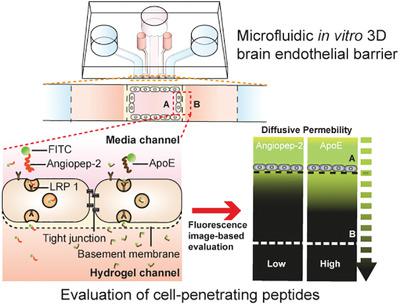当前位置:
X-MOL 学术
›
Macromol. Biosci.
›
论文详情
Our official English website, www.x-mol.net, welcomes your
feedback! (Note: you will need to create a separate account there.)
Evaluation of Cell-Penetrating Peptides Using Microfluidic In Vitro 3D Brain Endothelial Barrier.
Macromolecular Bioscience ( IF 4.4 ) Pub Date : 2020-04-24 , DOI: 10.1002/mabi.201900425 Bohye Chung 1 , Jaehoon Kim 2 , Jiyoung Nam 3 , Hyunho Kim 2 , Yeju Jeong 2 , Hui-Wen Liu 2 , Youngkyu Cho 4 , Yong Ho Kim 3 , Hyun Jeong Oh 2 , Seok Chung 1, 2, 4
Macromolecular Bioscience ( IF 4.4 ) Pub Date : 2020-04-24 , DOI: 10.1002/mabi.201900425 Bohye Chung 1 , Jaehoon Kim 2 , Jiyoung Nam 3 , Hyunho Kim 2 , Yeju Jeong 2 , Hui-Wen Liu 2 , Youngkyu Cho 4 , Yong Ho Kim 3 , Hyun Jeong Oh 2 , Seok Chung 1, 2, 4
Affiliation

|
In drug delivery to the human brain, blood vessels are a significant hurdle because they restrict the entry of most solutes to protect brain. To overcome this hurdle, an in vitro 3D model for brain endothelial barrier is developed using a microfluidic device with hydrogel providing a 3D extracellular matrix scaffold. Using the model, peptides known to utilize receptor‐mediated transcytosis are verified, which has been one of the most promising mechanisms for brain‐specific penetration. The cytotoxicity and cellular damage to the peptide are investigated and the receptor‐mediated transcytosis and brain endothelial specific penetrating abilities of the peptides in a quantitative manner are demonstrated. As a preclinical test, applying the quantification assays conducted in this study are suggested, including the penetrating ability, cytotoxicity, endothelial damage, and receptor specificity. Using this microfluidic device as an in vitro platform for evaluating various brain targeting drugs and drug carrier candidates is also proposed.
中文翻译:

使用微流体体外3D脑血管内皮屏障评估细胞穿透肽。
在向人脑输送药物时,血管是一个重要的障碍,因为它们限制了大多数溶质的进入以保护大脑。为了克服这一障碍,使用带有水凝胶的微流体装置开发了脑内皮屏障的体外3D模型,该模型提供了3D细胞外基质支架。使用该模型,已验证了已知利用受体介导的胞吞作用的肽,这已成为针对大脑特异性渗透的最有希望的机制之一。研究了该肽的细胞毒性和细胞损伤,并以定量的方式证明了该肽介导的受体介导的胞吞作用和脑内皮特异性穿透能力。作为临床前测试,建议应用本研究中进行的定量分析,包括穿透能力,细胞毒性,内皮损伤和受体特异性。还提出了将该微流体装置用作评估各种脑靶向药物和候选药物载体的体外平台。
更新日期:2020-04-24
中文翻译:

使用微流体体外3D脑血管内皮屏障评估细胞穿透肽。
在向人脑输送药物时,血管是一个重要的障碍,因为它们限制了大多数溶质的进入以保护大脑。为了克服这一障碍,使用带有水凝胶的微流体装置开发了脑内皮屏障的体外3D模型,该模型提供了3D细胞外基质支架。使用该模型,已验证了已知利用受体介导的胞吞作用的肽,这已成为针对大脑特异性渗透的最有希望的机制之一。研究了该肽的细胞毒性和细胞损伤,并以定量的方式证明了该肽介导的受体介导的胞吞作用和脑内皮特异性穿透能力。作为临床前测试,建议应用本研究中进行的定量分析,包括穿透能力,细胞毒性,内皮损伤和受体特异性。还提出了将该微流体装置用作评估各种脑靶向药物和候选药物载体的体外平台。











































 京公网安备 11010802027423号
京公网安备 11010802027423号